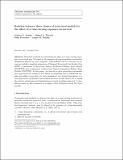Relation between three classes of structural models for the effect of a time-varying exposure on survival
Author(s)
Young, Jessica G.; Hernan, Miguel Angel; Picciotto, Sally; Robins, James A.
DownloadHernan_Relation between.pdf (189.1Kb)
PUBLISHER_POLICY
Publisher Policy
Article is made available in accordance with the publisher's policy and may be subject to US copyright law. Please refer to the publisher's site for terms of use.
Terms of use
Metadata
Show full item recordAbstract
Standard methods for estimating the effect of a time-varying exposure on survival may be biased in the presence of time-dependent confounders themselves affected by prior exposure. This problem can be overcome by inverse probability weighted estimation of Marginal Structural Cox Models (Cox MSM), g-estimation of Structural Nested Accelerated Failure Time Models (SNAFTM) and g-estimation of Structural Nested Cumulative Failure Time Models (SNCFTM). In this paper, we describe a data generation mechanism that approximately satisfies a Cox MSM, an SNAFTM and an SNCFTM. Besides providing a procedure for data simulation, our formal description of a data generation mechanism that satisfies all three models allows one to assess the relative advantages and disadvantages of each modeling approach. A simulation study is also presented to compare effect estimates across the three models.
Date issued
2009-11Department
Harvard University--MIT Division of Health Sciences and TechnologyJournal
Lifetime Data Analysis
Publisher
Springer Science + Business Media B.V.
Citation
Young, Jessica G. et al. “Relation between three classes of structural models for the effect of a time-varying exposure on survival.” Lifetime Data Analysis 16 (2009): 71-84.
Version: Author's final manuscript
ISSN
1572-9249
1380-7870